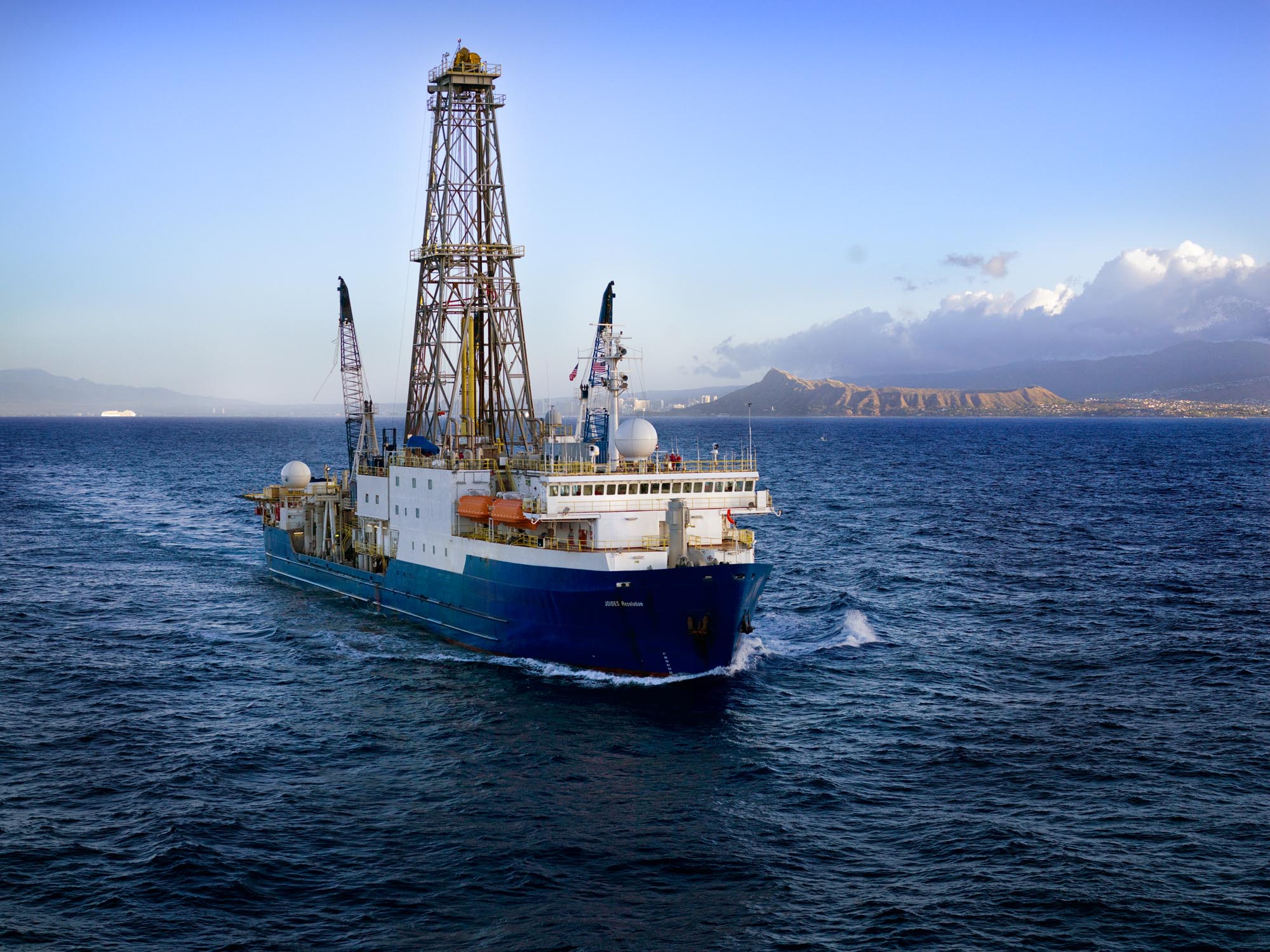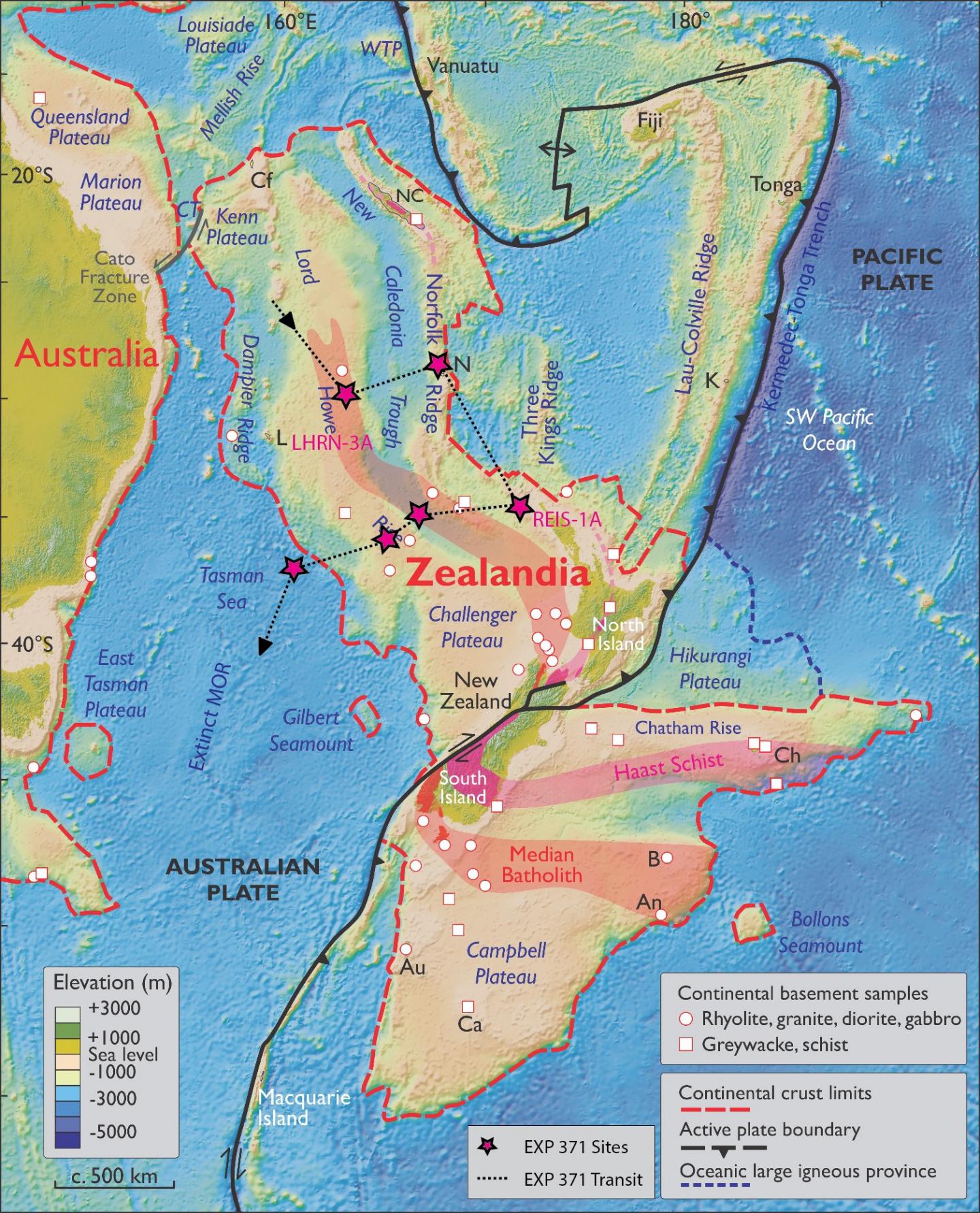Pekar’s July 25 Blog: The International Ocean Discovery Program Expedition 371: Tasman Sea Frontier
The International Ocean Discovery Program (IODP) Expedition 371: Tasman Sea Frontier (https://iodp.tamu.edu/scienceops/expeditions/tasman_frontier_subduction_climate.html) will drill below the sea floor to recover sediments deposited on the newly named 8th continent of the world called Zealandia. The expedition will take place on the JOIDES Resolution (JR), which is a large drilling ship specially constructed to obtain continuous sedimentary cores.

Figure 1. This is picture of the JOIDES Resolution the coast of Hawaii. Photo is from IODP.
The expedition has a number of goals that can be summed up in three general areas of study.
- To understand the tectonic history of this submerged continent that first rifted away from Australia about 80 million years ago (during the time of the dinosaurs). A fundamental question is to try to explain why this continent began to rise up and then sank again at around 50 million years ago. What is also so interesting is that many of the other tectonic plates changed their direction at around 50 million years as well. We will be try to determine the timing and magnitude of uplift and subsidence of Zealandia and explore what the connection is between these tectonics changes of Zealandia and the changes in global plate motions.
- To discover the connection between long-term tectonic changes and climate changes. For example, at 50 million years ago, the climate began to cool (about the same time Zealandia rose and tectonic plates changed direction). This was preceded by at least a hundred million years or more of extreme climate warmth.
- To decipher paleo-climate and paleoceanographic changes in this area of the world by generating high-resolution records for time intervals (60-16 million years ago) when atmospheric carbon dioxide was higher than today. These records can help understand how climate began a long cooling trend starting at about 50 million years ago. They can also provide a glimpse of what our planet will be like under elevated greenhouse gas conditions, in essence we will be “looking back to our future”.
For this expedition, the IODP drilling ship, the JOIDES Resolution, will set sail from Townsville, Australia, to drill five different sites over Zealandia and one site between Zealandia and Australia.

Figure 2. Base map showing the newly named continent called Zealandia (outlined in red dashed line). Also shown are the proposed drill sites for IODP Expedition 371 (red stars). We will be leaving from the city of Townsville (Northeastern Australia) and return on September 26 to the town of Hobart located in Tasmania.
There will be 30 scientists representing 12 countries on this expedition. In addition, for this expedition, a teacher from Australia and a videographer will join the science crew for the purpose of bringing live video conferencing to schools around the world as well as making short documentaries during the expedition. About 70 crew members and drillers will make up the rest of the compliment of people on the ship.
The science will run 24-hours a day, with the scientists being split into two shifts of 15 scientists each. I am on the midnight to noon shift. While that may sound a bit rough, actually when I wake up at 11 pm local time, it will be 9 am EDT in NYC. So I will be on the same time schedule as my hometown.
There will be scientists with expertise in just about every technique in examining sedimentary cores. Here is the list of the scientists on Ex 371. (https://iodp.tamu.edu/scienceops/precruise/tasman/participants.html)
We will have sedimentologists, like me, who will describe the sediments, paleontologists, actually micropaleontologists who will look at the tiny shells made by one-celled creatures that live in the upper part of the ocean as well as on the sea bottom, chemists who will do chemistry on the sediments and the micro fossils, remote sensing of the cores as well as scientists who will send instruments down the hole after we finish drilling to collect data about the sediments in the hole. So while the JR is a drill ship it is also a floating science research center.
“To boldly drill where no drilling bit has gone before”!
What is so special about being a scientist on the JR is that all the data collected by the 30 scientists while on the ship is SHARED with the other scientists. This is because we are all working together to explore and discover what secrets the sediments and fossils can tell us about past climate and tectonic changes. So it is the opposite of reality TV shows that bombard us all the time. On reality TV shows, the participants compete with each other, while on the JR the scientists cooperate to figure out cool science. Instead of Reality TV where contestants try to beat or win over each other, we share our results to work together in making new discoveries. It is indeed like being on the Starship Enterprise where we all work toward a common goal of scientific discovery as we drill in places that no one has drilled before.
The eight-week plus expedition will recover sedimentary archives of climate change as old as 60 million years ago. This will be accomplished by extending its drilling pipe from 5,000 feet (~1,500 meters) to over 13,000 feet (4,000 meters plus) of water to the sea floor and then drill down recovering sediments up to 3,000 feet (900 meters) below the sea floor. The older sediments were deposited during a time when the Earth was much warmer than today. In fact, Antarctica was mainly ice free and covered by lush forests during this time.
In my next blog, I will talk about in more detail about the science and goals of the expedition.